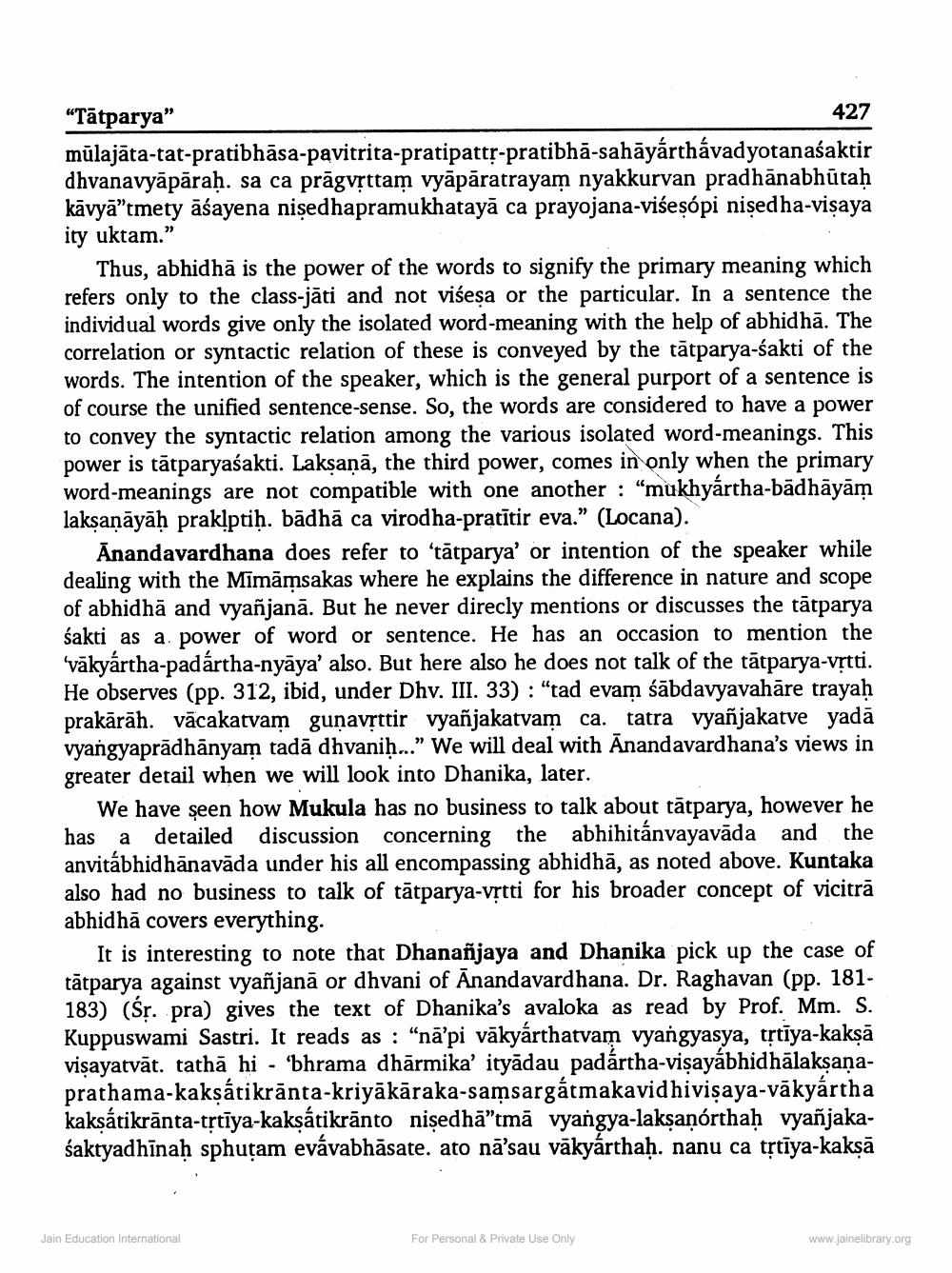________________
“Tātparya"
427 mūlajāta-tat-pratibhāsa-pavitrita-pratipattr-pratibhā-sahāyárthávadyotanaśaktir dhvanavyāpāraḥ. sa ca prāgvrttam vyāpāratrayam nyakkurvan pradhānabhūtah kāvyā”tmety āśayena niședhapramukhatayā ca prayojana-viśesópi nișed ha-visaya ity uktam."
Thus, abhidhā is the power of the words to signify the primary meaning which refers only to the class-jāti and not viśesa or the particular. In a sentence the individual words give only the isolated word-meaning with the help of abhidhā. The correlation or syntactic relation of these is conveyed by the tātparya-śakti of the words. The intention of the speaker, which is the general purport of a sentence is of course the unified sentence-sense. So, the words are considered to have a power to convey the syntactic relation among the various isolated word-meanings. This power is tātparyasakti. Laksanā, the third power, comes in only when the primary word-meanings are not compatible with one another : “mukhyartha-bädhāyām laksanāyāḥ prakļptiḥ. bādhā ca virodha-pratītir eva.” (Locana).
Anandavardhana does refer to 'tātparya' or intention of the speaker while dealing with the Mimāmsakas where he explains the difference in nature and scope of abhidhā and vyañjanā. But he never direcly mentions or discusses the tātparya śakti as a power of word or sentence. He has an occasion to mention the 'vakyārtha-padārtha-nyaya' also. But here also he does not talk of the tātparya-vrtti. He observes (pp. 312, ibid, under Dhv. III. 33) : “tad evam śābdavyavahāre trayah prakārāh. vācakatvam gunavrttir vyañjakatvam ca. tatra vyañjakatve yadā vyangyaprādhānyam tadā dhvanih..." We will deal with Anandavardhana's views in greater detail when we will look into Dhanika, later.
We have seen how Mukula has no business to talk about tātparya, however he has a detailed discussion concerning the abhihitánvayavāda and the anvitábhidhānavāda under his all encompassing abhidhā, as noted above. Kuntaka also had no business to talk of tātparya-vrtti for his broader concept of vicitrā abhidhā covers everything.
It is interesting to note that Dhananjaya and Dhanika pick up the case of tātparya against vyañjanā or dhvani of Anandavardhana. Dr. Raghavan (pp. 181183) (śr. pra) gives the text of Dhanika's avaloka as read by Prof. Mm. S. Kuppuswami Sastri. It reads as : "nā'pi vākyarthatvam vyangyasya, trtiya-kaksā visayatvāt. tathā hi - 'bhrama dhārmika' ityādau padártha-visayábhidhālakṣaṇaprathama-kakşátikrānta-kriyākāraka-samsargátmakavidhivisaya-vākyártha kaksátikrānta-trtīya-kaksátikrānto nisedhā"tmā vyangya-laksanórthah vyañjakaśaktyadhīnaḥ sphusam evávabhāsate. ato nā’sau vākyárthaḥ. nanu ca třtiya-kaksā
Jain Education International
For Personal & Private Use Only
www.jainelibrary.org




